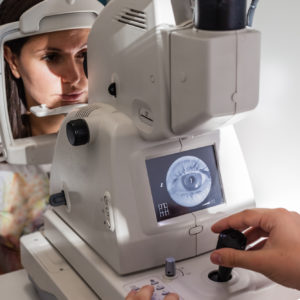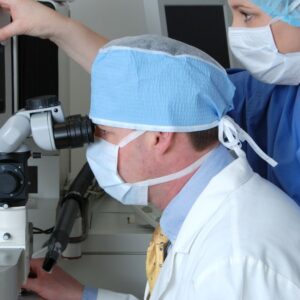Macular degeneration is a chronic eye condition that affects the retina, specifically the macula. The macula is a small, vital area at the back of your eye responsible for sharp, detailed vision.
Damage to the macula makes everyday activities such as reading, driving, recognizing faces, and seeing fine details significantly more difficult.
While macular degeneration usually does not cause total blindness, it remains one of the leading causes of permanent central vision loss, especially in adults over 50.
Understanding the Macula and Central Vision
The retina is a thin, delicate layer that lines the back of your eye. It acts much like a camera sensor, capturing light and images and sending them to your brain through the optic nerve so you can see.
- Read the small print.
- Recognize faces
- Drive safely
- See colors and contrast clearly.
- Focus on fine details.
What Is Macular Degeneration?
Macular degeneration develops when the cells in your macula gradually stop working as they should. This leads to a slow loss of central vision over time.
The condition most often appears as people get older, which is why it is commonly called age-related macular degeneration, or AMD.
What Causes Macular Degeneration?
Aging is the biggest risk factor. As you get older, the cells in your macula become less able to repair damage and clear away waste. This makes the macula more likely to break down, so macular degeneration is most often found in people over 50.
Genetics also plays a role. People with a family history of macular degeneration are more likely to develop the condition themselves, suggesting that inherited traits can influence the retina’s resilience to long-term stress.
Your lifestyle and overall health are important too. Smoking is a major risk factor because it lowers oxygen and blood flow to the retina and causes more damage. Health problems like high blood pressure, high cholesterol, and heart disease can also reduce healthy blood flow to your eyes. Being overweight or having poor metabolic health can increase your risk as well.
Environmental factors matter too. Being in sunlight or blue light for long periods, especially without eye protection, can put extra stress on your retina. Nutrition is also important. If your diet is low in antioxidants and other helpful nutrients, your retina may not be able to protect itself as well.
In rare cases, some inherited retinal diseases like Stargardt disease can cause macular damage in children or young adults.
Types of Macular Degeneration
There are two main types of macular degeneration, each affecting the eye differently and requiring different treatment approaches.
Dry Macular Degeneration
- Gradual thinning of macular tissue
- Accumulation of drusen, small yellow deposits beneath the retina
- Vision loss that develops slowly over many years
Wet Macular Degeneration (Neovascular)
- Abnormal blood vessels grow beneath the retina.
- These vessels leak fluid or blood.
- Retinal cells are rapidly damaged.
Stages of Age-Related Macular Degeneration
Early Stage
- Small drusen present
- No noticeable vision changes
- Detected only during eye examinations
Intermediate Stage
- Larger drusen and pigment changes
- At this stage, you may start to notice subtle changes in your vision.
- Higher risk of progression
Late (Advanced) Stage
- Severe central vision loss
- Geographic atrophy (advanced dry AMD) or wet AMD
- Vision loss at this stage is usually permanent and irreversible.
Who Is at Risk of Macular Degeneration?
- Adults over 50
- Smokers or former smokers
- Individuals with a family history of AMD
- Those with cardiovascular disease
- People with obesity
- Individuals with light-colored eyes
- Women (partly due to longer life expectancy)
- People with long-term UV exposure
- Diets high in saturated fats and processed foods
Symptoms of Macular Degeneration
The symptoms of macular degeneration can vary depending on the type of the disease and its severity. In many cases, changes develop gradually and may go unnoticed at first.
As the condition progresses, central vision often becomes blurred or less sharp, making it harder to focus on details. Straight lines may begin to look wavy or distorted, especially when reading or looking at door frames and window edges. Tasks that rely on fine vision, such as reading small print or recognizing faces, can become increasingly difficult.
How is Macular Degeneration Diagnosed?
- Visual acuity testing
- Dilated retinal examination
- Amsler grid testing for distortion
- Optical Coherence Tomography (OCT) is a special scan that gives detailed images of your retina.
- Fluorescein angiography to detect leaking blood vessels
- Indocyanine green angiography in selected cases
Treatment of Macular Degeneration
Is There a Cure?
Management of Early and Intermediate Dry AMD
- Nutrient-rich diet (leafy greens, fish, antioxidants)
- AREDS-based supplements for appropriate patients
- Smoking cessation
- Blood pressure and cholesterol control
- Regular eye exams to check for changes
Treatment of Wet Macular Degeneration
Anti-VEGF Injections
- First-line treatment
- Blocks abnormal blood vessel growth
- Given as regular intravitreal injections
- These injections can help stabilize your vision, and for some people, they may even lead to some improvement.
Photodynamic Therapy
- Uses light-activated medication
- Reserved for selected cases
Laser Therapy
- Less commonly used today.
- Targets abnormal vessels in specific situations
Living With Macular Degeneration
- Magnifying devices and electronic aids
- Improved lighting strategies
- High-contrast reading tools
- Vision rehabilitation training
Key Facts About Macular Degeneration
- Leading cause of central vision loss in older adults
- Dry AMD is more common; wet AMD causes faster vision loss.
- Smoking significantly increases risk.
- Early detection preserves vision.
- Research into new therapies is ongoing.
When Should I See an Eye Doctor?
You should see an eye doctor if you notice any change in your central vision, even if it seems mild at first. This can include blurred or distorted vision, straight lines that look wavy, difficulty reading, or trouble recognizing faces.
People over the age of 50 should also schedule regular eye exams, especially if they have risk factors for macular degeneration such as smoking, a family history of AMD, high blood pressure, or cardiovascular disease.
Early macular degeneration may not cause noticeable symptoms, but it can often be found during a comprehensive eye exam. Getting checked promptly allows for earlier monitoring and treatment, which can help preserve your vision and lower the risk of sudden changes.






